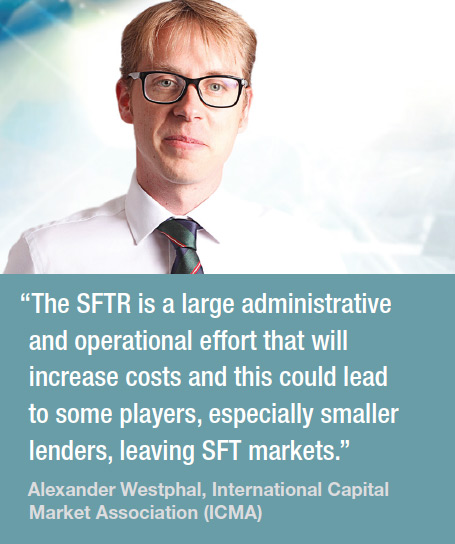By Lynn Strongin Dodds.
The delay to the regulation gives market participants more breathing room but they should not get too comfortable. Lynn Strongin Dodds looks at the preparations required.
The goalposts have moved for the Securities Financing Transaction Regulation (SFTR), which shines a brighter light into securities lending, repo and margin lending activity. The new rules, which require reporting of securities financing transactions, are now unlikely to go live until the first half of 2019, a year later than expected. While the industry welcomes the breathing space, investment firms are advised to start devising a blueprint for compliance now.
Under SFTR, market participants for the first time will have to submit their trade and collateral data at the end of T+1 and S+1 respectively to a registered trade repository. Unlike the European Markets and Infrastructure Regulation (EMIR), the remit entails dual-side reporting and covers not only the counterparties involved in a trade but also principal amount, currency, collateral assets, repo rate, lending fee, margin lending rate, haircut and maturity date. It also necessitates record keeping for up to five years of any SFT, following termination of the transaction.
 Alexander Westphal, director for Market Practice and Regulatory Policy at the International Capital Market Association (ICMA), says, “The SFTR is a large administrative and operational effort that will increase costs and this could lead to some players, especially smaller lenders, leaving SFT markets. We also see firms turning to platforms to facilitate reporting because the information is captured in a more harmonised way. This in turn could lead to an increase in electronic trading.”
Alexander Westphal, director for Market Practice and Regulatory Policy at the International Capital Market Association (ICMA), says, “The SFTR is a large administrative and operational effort that will increase costs and this could lead to some players, especially smaller lenders, leaving SFT markets. We also see firms turning to platforms to facilitate reporting because the information is captured in a more harmonised way. This in turn could lead to an increase in electronic trading.”
The rules will apply to an EU branch of a third-country counterparty. For example if a US pension fund conducted a securities lending transaction with a Paris office of a Swiss bank, it would be in scope even though neither the lender nor the borrower’s principal office is in the EU.
“At the moment, most banks and buy-side firms are focused on MiFID II and not thinking about the SFTR,” says Paul Burleton, head of strategy, regulatory, risk and compliance at IT consulting group GFT. “However, given the sheer scale of the work that will be required, we are pushing organisations to start to thinking about their trade flows, data requirements and operating models in order to figure out what they will need to comply.”
The European Securities and Markets Authority (ESMA) delayed the publication of the final technical standards by three months, issuing them on 31 March 2017, in part to take in points from the Financial Stability Board’s report issued on 25 January 2017 on ‘Non-cash collateral re-use: Measure and Metrics.’ According to the International Securities Lending Association, the delegated act containing the RTS enters into force 20 days after Official Journal publication. If that were to occur at the end October 2017, that would constitute the trigger for all the Article 4 requirements with the reporting obligations rolling out, starting with banks and investment firms applying 12 months afterwards – the end of October 2018 – and continuing until the final reporting obligations to come into effect for non-financial counterparties at the end of July 2019.

“One of the main problems is that the rules are much more complex than the European Market Infrastructure Regulation (EMIR) and many reportable fields are not required in the SFT market today” says Ian Chester, marketing manager for regulatory reporting services at Broadridge. “The other main challenge is the disclosure requirements within the ESMA timeframes.”
A widening field
Overall, there are about 110 pieces of data that need to be reported, and a significant chunk is transacted across potentially hundreds of lenders. Firms will also have to supply around 60 matched fields that need to be agreed with their counterparties within very tight, or zero, tolerances. This is approximately six times the number of fields needed under EMIR.
Another contentious obligation is the need to report collateral throughout the lifecycle of the SFT. This includes whether it is available for re-use or has been re-used as well as the substitution of collateral at the end of the day and the haircuts applied.
“Firms will have to obtain permission for re-hypothecation of collateral, as well an assessment of the risks and consequences of such activity,” says David Lewis, senior vice president at system provider FIS. “Typically, an agent lender in receipt of collateral on behalf of the investment fund is unlikely to use that collateral for any other purposes while it remains in their custody, but it is expected that most will make arrangements and obtain permissions to cover this option.
Westphal believes that “the collateral reporting obligations are among the most challenging issues but ESMA in its final technical standards did listen to the industry on some important aspects. For example, they decided not to impose the collateral valuation methodology”.
The concern was that it was going to apply IFRS 13 Fair Value Measurement, which “we argued against because we did not think it was appropriate for daily reporting,” he adds.
The final standards also provided detailed information on the use of ISO 20022 methodology for reporting, validation and access to data as well as standardised identifiers such as Legal Entity Identifier, Unique Transaction Identifier and the International Securities Identification Number.
While it is too early to predict the bearing SFTR will have on collateral re-use and valuation, Pierre Khemdoudi, managing director at IHS Markit, believes the initial impact will be minimal.
“The aim of the regulation is to create greater transparency which means that firms will now have to report re-hypothecation and valuation of their collateral,” he says. “I think in the long term, the regulation will have more of an effect on repo than securities lending which is a well-established collateralised business with significant margins to cover market moves.”
Repo has already been hit hard by the Basel III requirements which have made capital constrained banks withdraw from the market. There are fears that the new rules would only exacerbate the situation.
Mark Byrne, SFTR product specialist, at securities lending platform EquiLend believes that the smaller players in the repo market will either move to a platform or exit the business.
“Many firms have manual processes to access the information and they have to decide whether they have the bandwidth to meet the daily reporting requirements,” he says. “However, although there are challenges, there are also opportunities in that the SFTR will improve operational efficiencies as well as settlement across the industry.”
The data management challenge
For now the main focus will be on having the requisite infrastructure in place to cross the SFTR finishing line in 2019. The task should not be underestimated especially for the buy side, according to a recent global survey conducted by Adox Research conducted on behalf for SimCorp. It found that almost half of the asset managers surveyed were using order management systems that were at least ten years old. This not only made it harder to keep pace with the roll out of new regulations but also the new instruments or geographic markets covered within the legislation. The result is that managers are forced to take it outside of the system and proceed manually, facing increased operational risk, according to Paul Michael, product manager, IBOR Domain at SimCorp.

Vendors have been developing solutions, often in partnership with other industry participants. For example, Equilend in collaboration with industry bodies, clients, triparty agents and trade repositories is developing an automated, consolidated, scalable solution that removes the necessity for manually intensive intervention.
IHS Markit, has teamed up with Pirium to combine its Markit Securities Finance’s data handling and management offerings with Pirium Systems’ post-trade reconciliation capabilities to launch a fully hosted, end-to-end service by the end of the year.
Legacy systems will continue to present a major stumbling block with close to 40% of all core investment data in the front office being spread across ten or more databases.
“Both SFTR and the more widely encompassing MiFID II, highlight the growing need to break the siloes of front, middle and back office, and the long-term opportunity for technology consolidation, to effectively tackle market-led operational changes,” Michael says. “When you have several systems interfacing together within this process from front to back offices, implementation of regulatory changes become that much harder than if you operate on one system that traverses the front, middle and back office.”
©Markets Media Europe 2025













